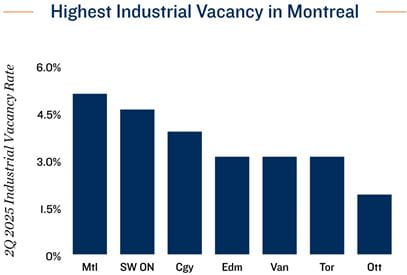Research Brief
Canada Industrial
July 2025

Inventory Rebalancing While Production Slack Continues
Manufacturing losses narrow. Manufacturing activity stabilized in May, as USMCA-compliant exports continued to enjoy preferential treatment. Although total sales fell by 0.9 per cent month over month, this weakness was almost entirely due to an 8.4 per cent drop in sales of petroleum and coal products. The energy industry underperformed primarily because of several shutdowns across refineries in Quebec, Alberta, Ontario and Saskatchewan. Excluding this lagging sector, the decline in total sales narrowed to just 0.1 per cent – a significant improvement from April’s 1.7 per cent drop. Despite still-sluggish overall sales, shipments of aerospace products and parts – one of the sectors least affected by tariffs – rose 6.9 per cent, reaching the second-highest level on record.
Inventory levels adjusting to new tariff regime. As May marked the first month after the United States paused the “Liberation Day” tariffs, fewer manufacturers reported being affected by these levies compared with April. The easing of trade tensions helped demand visibility, slowing the de-stocking trend among manufacturers. This was reflected in the more modest 1.2 per cent year-over-year decline in inventory – a noticeable improvement from the 4.7 per cent drop in January. Wholesale inventories also returned to a slow pace of growth, representing a shift from excess caution to just-in-time inventory practices. In the industrial sector, while net absorption softened between April and June, the evolving inventory trends – if sustained – could help strengthen leasing activity moving forwards.
Quebec under pressure from higher tariffs. With a large production base, Quebec saw total manufacturing sales fall in May to their lowest level since December 2021, despite a 4.5 per cent increase in aerospace product and parts shipments. While refinery shutdowns contributed to this weakness, broader softness across key industries – including primary metals and chemical products – also weighed on overall performance. The province’s outsized exposure to tariff-sensitive sectors and export-oriented manufacturing made it more vulnerable to trade disruptions. As a result, Quebec’s industrial sector remains under greater pressure compared with other provinces. Montreal’s vacancy rate reached 5.1 per cent in the second quarter – the highest among major Canadian metros. In the investment market, this weakness likely influenced transaction activity as well. Preliminary second-quarter data shows the number of deals fell by 67 per cent and dollar volume dropped by 70 per cent year over year in Montreal – the sharpest declines among eastern metros.
Policy pause anticipated amid trade talks. The stabilization in May’s manufacturing activity amid easing trade tensions is likely in line with the Bank of Canada’s expectations. Alongside other economic data – including the recent upside surprise in the job market and an uptick in June’s inflation – the central bank is expected to hold rates steady at its July meeting. With trade negotiations set to intensify ahead of the August deadline, which could meaningfully reduce uncertainty, monetary policymakers will likely remain on the sidelines for now but stand ready to cut rates if necessary.


* Net absorption data through 2Q, inventory data through May; ^ Trailing 12-month total
Sources: Marcus & Millichap Research Services; Altus Data Solutions; Statistics Canada
TO READ THE FULL ARTICLE

